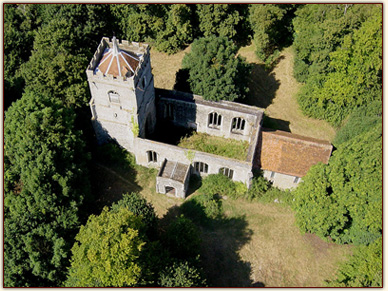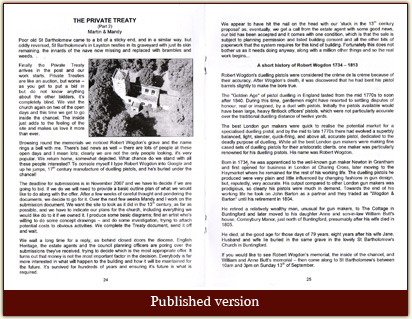Martin & Mandy

Poor old St Bartholomew came to a bit of a sticky end, and in a similar way, but oddly reversed, St Bartholomew’s in Layston nestles in its graveyard with just its skin remaining, the innards of the nave now missing and replaced with brambles and weeds.
 Finally the Private Treaty arrives in the post and our work starts. Private Treaties are like an auction, but worse -as you get to put a bid in but do not know anything about the other bidders, it’s completely blind. We visit the church again on two of the open days and this time we get to go inside the chancel. The inside just adds to the feeling of the site and makes us love it more than ever.
Finally the Private Treaty arrives in the post and our work starts. Private Treaties are like an auction, but worse -as you get to put a bid in but do not know anything about the other bidders, it’s completely blind. We visit the church again on two of the open days and this time we get to go inside the chancel. The inside just adds to the feeling of the site and makes us love it more than ever.
Browsing round the memorials we noticed Robert Wogdon’s grave and the name rings a bell with me. There’s bad news as well - there are lots of people at these open days and I mean lots; clearly we are not the only people looking, it’s very popular. We return home, somewhat dejected. What chance do we stand with all these people interested? To console myself I type Robert Wogdon into Google and up he jumps, 17th century manufacture of duelling pistols, and he’s buried under the chancel!
The deadline for submissions is in November 2007 and we have to decide if we are going to bid. If we do we will need to provide a basic outline plan of what we would like to do along with the offer. After a few weeks of careful thought and pondering the documents, we decide to go for it. Over the next few weeks Mandy and I work on the submission document. We want the site to look as it did in the 13th century, as far as possible, and we have to indicate our plans for the church, including everything we would like do to it if we owned it. I produce some basic diagrams; find an artist who’s willing to do some concept drawings - and do some investigation, trying to attach potential costs to obvious activities. We complete the Treaty document, send i( off and wait.
We wait a long time for a reply, as behind closed doors the diocese, English Heritage, the estate agents and the council planning officers are poring over the submissions they’ve received, trying to decide which is the most appropriate offer. It turns out that money is not the most important factor in the decision. Everybody is far more interested in what will happen to the building and how it will be maintained for the future. It’s survived for hundreds of years and ensuring it’s future is what is required.
We appear to have hit the nail on the head with our ‘stuck in the 13th century proposal’ as, eventually, we get a call from the estate agent with some good news, our bid has been accepted and it comes with one condition, which is that the sale is subject to planning permission and listed building consent and all the other bits of paperwork that the system requires for this kind of building. Fortunately this does not bother us as it needs doing anyway, along with a million other things and so the real work begins...
Robert Wogdon’s duelling pistols were considered the creme de la creme because of their accuracy. After Wogdon’s death, it was discovered that he had bent his pistol barrels slightly to make the bore true.
The “Golden Age” of pistol duelling in England lasted from the mid 1770s to soon after 1840. During this time, gentlemen might have resorted to settling disputes of honour, real or imagined, by a duel with pistols. Initially the pistols available would have been large, heavy flintlock officers’ pistols, which were not particularly accurate over the traditional duelling distance of twelve yards.
The best London gun makers were quick to realise the potential market for a specialised duelling pistol, and by the mid to late 1770s there had evolved a superbly balanced, light, slender, quick-firing, and above all, accurate pistol, dedicated to the deadly purpose of duelling. While all the best London gun makers were making fine cased sets of duelling pistols for their aristocratic clients, one maker was particularly renowned for his duelling pistols. His name was Robert Wogdon.
Born in 1734, he was apprenticed to the well-known gun maker Newton in Grantham and first opened for business in London at Charing Cross, later moving to the Haymarket where he remained for the rest of his working life.  The duelling pistols he produced were very plain and little influenced by changing fashions in gun design, but, reputedly, very accurate. His output compared to other London gun makers was prodigious, so clearly his pistols were much in demand. Towards the end of his working life he took on John Barton as a partner and they traded as “Wogdon & Barton” until his retirement in 1804.
The duelling pistols he produced were very plain and little influenced by changing fashions in gun design, but, reputedly, very accurate. His output compared to other London gun makers was prodigious, so clearly his pistols were much in demand. Towards the end of his working life he took on John Barton as a partner and they traded as “Wogdon & Barton” until his retirement in 1804.
He retired a relatively wealthy man, unusual for gun makers, to The Cottage in Buntingford and later moved to his daughter Anne and son-in-law William Butt’s house, Corneybury Manor, just north of Buntingford, presumably after his wife died in 1805.
He died, at the good age for those days of 79 years, eight years after his wife Jane. Husband and wife lie buried in the same grave in the lovely St Bartholomew’s Church in Buntingford.
If you would like to see Robert Wogdon’s memorial, the inside of the chancel, and William and Anne Butt’s memorial - then come along to St Bartholomew’s between 10am and 3pm on Sunday 13th of September.
 |
|
 |
